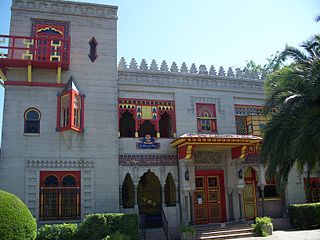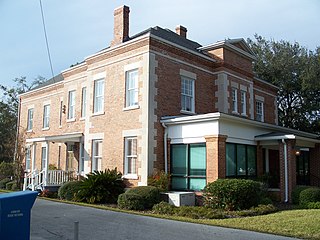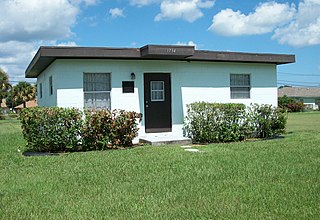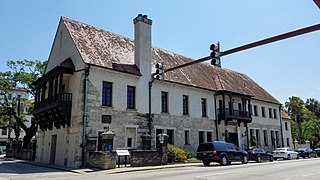
The Lightner Museum is a museum of antiques, mostly American Gilded Age pieces, housed within the historic Hotel Alcazar building in downtown St. Augustine. This 1887 Spanish Renaissance Revival style building is listed on the National Register of Historic Places.

Mission San Luis de Apalachee was a Spanish Franciscan mission built in 1656 in the Florida Panhandle, two miles west of the present-day Florida Capitol Building in Tallahassee, Florida. It was located in the descendent settlement of Anhaica capital of Apalachee Province. The mission was part of Spain's effort to colonize the Florida Peninsula and to convert the Timucuan and Apalachee Indians to Christianity. The mission lasted until 1704 when it was evacuated and destroyed to prevent its use by an approaching militia of Creek Indians and South Carolinians.

Villa Zorayda is a house at 83 King Street in St. Augustine, Florida. Built in 1883 by the eccentric Boston millionaire Franklin W. Smith as his winter home, it was inspired by the 12th-century Moorish Alhambra Palace in Granada, Spain. Smith named it "Villa Zorayda", after one of the princesses in Washington Irving's Tales of the Alhambra. The building and part of Franklin Smith's art and antique collection were sold to Abraham Mussallem, a rug and antiquities merchant originally from Syria, in 1913. On September 23, 1993, it was added to the U.S. National Register of Historic Places. The Villa Zorayda Museum is still owned by the Mussallem family and contains the original art and antique collection assembled by Franklin Smith and Abraham Mussallem.

The Mala Compra Plantation Archeological Site is an archaeological site in Palm Coast, Florida, on the east bank of the Matanzas River. It is located west of the intersection of State Road A1A and Mala Compra Drive at Bings Landing County Park in Flagler County. On March 5, 2004, it was added to the United States National Register of Historic Places.

The Sanchez Powder House Site is a historic site in St. Augustine, Florida. It is located on Marine Street. On April 14, 1972, it was added to the U.S. National Register of Historic Places.
San Juan de Aspalaga was a mission in the Apalachee Province of Spanish Florida established by Franciscans. It first appears in Spanish records in 1655, when it was located at a distance of 86 leagues from St. Augustine, which would place it in the western part of Apalachee Province. By 1675, Aspalaga had moved eastward to the archaeological site known as the Pine Tuft Site, near the present-day town of Wacissa, Florida, about 78 leagues from St. Augustine. By 1695, or at least by 1697, Aspagala had moved back to the western part of Apalachee Province. Aspagala had a population of about 800 in 1675, which had fallen to 250 by 1689. Aspalaga was overrun on June 24, 1704, by Muscogees allied with the Province of Carolina, part of the Apalachee massacre.

The Old Taylor County Jail is a historic jail in Perry, Florida, located on the 400 block of North Washington Street. It was built in 1912 and was listed on the National Register of Historic Places in 1989.

The Hotel Blanche is a historic site in Lake City, Florida, United States. It is located at 212 North Marion Street. On January 18, 1990, it was added to the U.S. National Register of Historic Places.

The Zora Neale Hurston House is a historic house at 1734 Avenue L in Fort Pierce, Florida. Built in 1957, it was the home of author Zora Neale Hurston (1891–1960) from then until her death. On December 4, 1991, it was designated as a U.S. National Historic Landmark.

The Llambias House is a historic house located at 31 Saint Francis Street in St. Augustine, Florida. Built sometime before 1763, it is one of the few houses in Florida to survive from the first period of Spanish Florida. It was designated a National Historic Landmark on April 15, 1970. The house is now managed by the St. Augustine Historical Society as an event venue.

The González–Álvarez House, also known as The Oldest House, is a historic house museum at 14 St. Francis Street in St. Augustine, Florida. With a construction history dating to about 1723, it is believed to be the oldest surviving house in St. Augustine. It is also an important example of St. Augustine's Spanish colonial architectural style, with later modifications by English owners. It was designated a U.S. National Historic Landmark in 1970. The house is now owned by the St. Augustine Historical Society and is open for public tours as part of the Oldest House Museum Complex. Evidence can be seen of the Spanish, British, and American occupations of St. Augustine.

The Cathedral Basilica of St. Augustine is a historic cathedral in St. Augustine, Florida, and the seat of the Catholic Bishop of St. Augustine. It is located at 38 Cathedral Place between Charlotte and St. George Streets. Constructed over five years (1793–1797), it was designated a U.S. National Historic Landmark on April 15, 1970. Its congregation, established in 1565, is the oldest Christian congregation in the contiguous United States.

The Avero House is a historic house located at 41 St. George Street in St. Augustine, Florida, United States. The building is locally significant as one of 30 remaining houses within the historic district that pre-date 1821. It was once the site of a Minorcan Chapel. Today, the building is home to the St. Photios Greek Orthodox National Shrine.

Grace United Methodist Church is a historic church donated to the people of St. Augustine, Florida, by American industrialist Henry Morrison Flagler. It is located at 8 Carrera Street. Built within a one-year span, it was added to the U.S. National Register of Historic Places on November 29, 1979, for its architectural significance and as an example of community planning.

Markland, also known as the Andrew Anderson House, is a historic mansion in St. Augustine, Florida. It was built in the Greek Revival style of Classical Revival architecture.

The O'Reilly House, known officially known as the Father Miguel O'Reilly House Museum, and also known as the House of Don Lorenzo de Leon, is a historic home in St. Augustine, Florida. It is located at 131 Aviles Street. On October 15, 1974, it was added to the U.S. National Register of Historic Places.

The Rodriguez-Avero-Sanchez House is a historic home in St. Augustine, Florida. It is located at 52 St. George Street. It was built in 1762. On April 16, 1971, it was added to the U.S. National Register of Historic Places.

The Xavier Lopez House is a historic home in St. Augustine, Florida, United States. It is located at 93½ King Street. It was built in 1903 in the Queen Anne/Victorian style, which is atypical of many structures in St. Augustine, most of which are in the Spanish/Mission Revival style. The house is located behind a trio of one-story Spanish colonial-style mortgage lending offices, all of which are addressed as being at 93 King Stret.

Government House, also known as Governor's House, is located at 48 King Street in St. Augustine, Florida, adjacent to the Plaza de la Constitución. The building, constructed of coquina, served as the governor's official residence from c. 1710 during the First Spanish Period (1565–1763), throughout the British Period (1763–1784), and until 1812 in the Second Spanish Period (1784–1821). Governor Gonzalo Méndez de Canzo was the first governor to build his residence on the present Government House site in 1598.

For the Oldest House Museum in Key West, Florida see Old Island Restoration Foundation




















